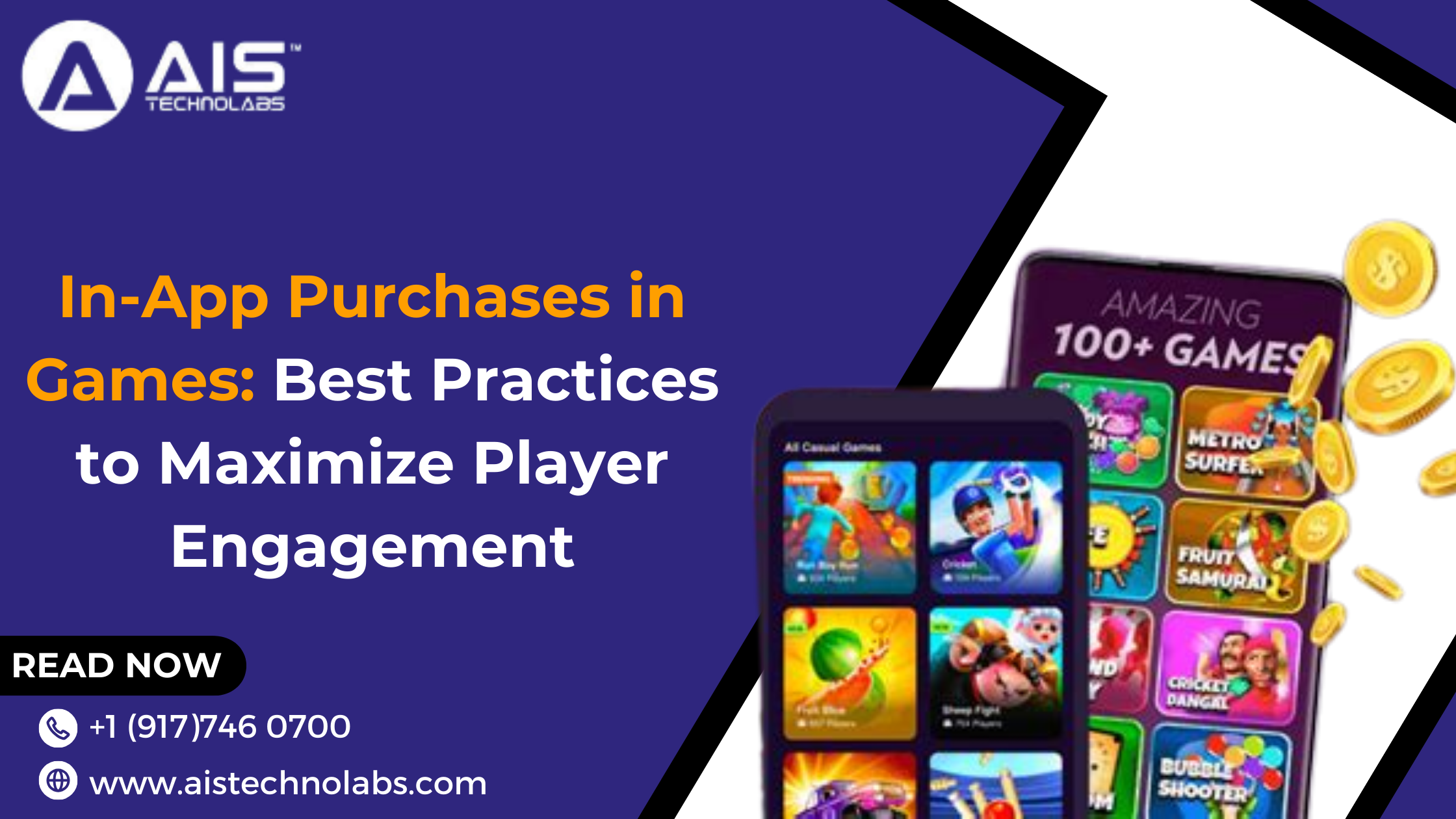Table of Content
(630 views)

Introduction: Why In-App Purchases Are Essential for Game Developers
The mobile gaming industry has experienced exponential growth over the past decade, inspired by the emergence of smartphones, Internet use, and the increasing popularity of random sports. Due to market maturing, game developers constantly ask for new ways of generating revenue while catching players. One of the most common and effective methods is the integration of the purchase into the app.
In-app purchases allow developers to muddy their game by buying virtual goods or by providing an opportunity to unlock more materials and features. This model has become the backbone of several free-to-games, ensuring that developers can take advantage of their creations without the need to buy one in advance. But how can game developers design purchases in the app that not only has revenue but also increase the player's experience? The answer lies in a thoughtful approach as a preference engagement and the player's satisfaction.
In-app purchases allow developers to muddy their game by buying virtual goods or by providing an opportunity to unlock more materials and features. This model has become the backbone of several free-to-games, ensuring that developers can take advantage of their creations without the need to buy one in advance. But how can game developers design purchases in the app that not only has revenue but also increase the player's experience? The answer lies in a thoughtful approach as a preference engagement and the player's satisfaction.
Why In-App Purchases Are a Game-Changer
In-app purchases revolutionized the gaming industry by offering a stable part of the revenue without having to put the players. This model gives players the freedom to download and experience a game without financial commitment, making it more accessible to a wider audience. When players are invested in gameplay, they are more likely to spend money on objects in the game that increase the experience, whether through cosmetic objects, boosters, or unlocked material.
For developers, the in-app purchase model offers a sustainable revenue stream, enabling continuous game updates and improvements. This approach keeps players engaged while enhancing their lifetime value (LTV). According to Grand View Research, the in-app purchase market is experiencing significant growth, driven by increasing smartphone penetration and evolving user preferences. From a player’s perspective, this model can be highly beneficial when implemented correctly. It enhances the gaming experience by providing valuable content and convenience, allowing players to enjoy new features, bypass repetitive tasks, and maintain uninterrupted enjoyment.
What Makes In-App Purchases a Win-Win for Developers & Players?
The appeal of in-app purchases (IAPs) lies in their ability to benefit both game developers and players. For game developers, IAPs provide a flexible and scalable method for monetizing their games. They enable developers to generate a consistent revenue stream, even if players do not opt to make purchases. Additionally, game developers can leverage data-driven insights to optimize their IAP offerings, ensuring they stay relevant and attractive to their target audience.
For players, in-app purchases provide an elective way to beautify gameplay. Instead of being compelled to spend money in advance, players can pick out whichever way they want to spend money on the sport, making it like a more personalized experience. The key to success lies in making those purchases experience significant and rewarding, in preference to intrusive or exploitative.
Driving Revenue Without Annoying Players
One of the biggest challenges for developers is ensuring that in-app purchases don’t detract from the general player revel in. Too many intrusive pop-ups or a game’s progression device that heavily favors paid content material can quick flip gamers off, damaging long-time period engagement and retention. Striking a stability is critical—builders need to create an experience in which in-app purchases experience like a bonus rather than a necessity.
The most successful games design in-app purchases as an non-compulsory enhancement to the revel in, permitting gamers to enjoy the sport without feeling like they’re being forced into spending money. Moreover, the purchases must be priced as it should be to avoid alienating casual gamers who might not be willing to spend plenty however nevertheless want to enjoy the game.
Understanding Your Players: Why Engagement Matters
Engagement is the cornerstone of any successful sport, mainly in terms of monetization. Understanding the motivations, choices, and behaviors of your participant base is vital for designing an IAP machine that works. It’s important to understand that distinct gamers can have one-of-a-kind spending conduct. Some may additionally pick to buy beauty gadgets, while others would possibly prioritize sport development or content material unlocks.
For developers, this means it’s vital to invest in statistics analytics and behavioral monitoring. By know-how how players interact with the sport and what features they interaction with the most, developers can craft IAP systems that feel herbal and attractive. This level of personalization and attention to detail could make an enormous distinction in how gamers view and reply to in-app purchases.
Knowing What Drives Players to Spend
What motivates players to spend money in a game? The key is to offer value, convenience, and personalization. Players are more likely to spend money if they feel that their purchase will enhance their overall experience or make their progress smoother. This can be achieved through various means, such as offering exclusive content, time-limited items, or boosts that help players save time and effort.
Monetizing a sport is essential for the long-time period sustainability of a venture, but it’s critical not to compromise the laugh element. Games that focus too heavily on monetization can frustrate players and force them away. In comparison, video games that concentrate on player revel in first, with monetization factors included seamlessly into the sport, will see greater fulfillment ultimately.
Fine Line Between Fun and Monetization
Monetizing a sport is crucial for its long-term sustainability, but it’s important not to compromise the fun factor. Games focusing too much on monetization can frustrate players and push them away. Instead, prioritizing player experience while integrating monetization seamlessly leads to greater success. Developers should ensure monetization strategies are unobtrusive and don't disrupt gameplay. For example, offering premium content that enhances the experience without interrupting the game flow is key. In-app purchases should feel like an enhancement, not a crutch, and never hinder the player’s enjoyment of the game.
Types of In-App Purchases
There are various types of in-app purchases, each with its own advantages and potential drawbacks. Understanding which type of IAP works best for your game can help you maximize revenue and player satisfaction. Here are some common types:
- Cosmetic Items – These include skins, costumes, and other visible enhancements that don’t affect gameplay but provide gamers a way to customise their experience.
- Consumables – These are items that players can use once, such as boosts, health potions, or temporary advantages. They encourage frequent spending as players return to buy more.
- Unlockable Content – This includes additional levels, characters, or storylines that are available for purchase. It allows players to enjoy extra content and expands the game’s lifespan.
- Subscriptions – Some games offer subscription-based models that provide gamers with continuous advantages, which includes daily rewards, exceptional content, or ad-unfastened reviews.
Best Practices for Designing In-App Purchases
To maximize revenue and user engagement, game development companies should follow best practices for designing in-app purchases. Offer a mix of consumable and non-consumable items, ensuring they provide real value to players. Use transparent pricing, avoid pay-to-win mechanics, and implement limited-time offers to boost conversions. Personalize offers based on user behavior and keep the purchasing process seamless for a better gaming experience.
- Offer Fair Value: The prices of items should reflect their worth in terms of gameplay enhancement. Players should feel like they’re getting a good deal.
- Make It Optional: Ensure that in-app purchases enhance the player's enjoyment but aren’t essential to development.
- Transparent Pricing: Be clear about what players are getting with their purchases. Avoid hidden costs or confusing pricing structures.
- Test and Iterate: Continuously monitor how players are interacting with in-app purchases and adjust your offerings accordingly.
Timing & Placement of In-App Purchases for Maximum Engagement
The timing and placement of in-app purchase activates are vital in retaining engagement without being intrusive. For example, displaying an offer on the right moment—along with whilst a player reaches a tough degree or when they’ve made a widespread fulfillment—can growth the likelihood of a buy. However, builders need to keep away from bombarding game enthusiasts with steady reminders or restricting gameplay till players make a buy.
Building Player Loyalty: How to Make Players Want to Spend
Building player loyalty is essential for driving consistent in-app purchases. Offering rewards for regular play, such as daily bonuses or exclusive content, can incentivize players to spend more over time. Additionally, maintaining clear communication with players through in-game events, updates, and limited-time offers can keep them engaged and excited to make purchases.
Analyzing Player Behavior: Test, Learn, Improve
To refine your IAP strategy, it’s essential to analyze player behavior and make data-driven decisions. A/B testing different IAP offerings, prices, and placements can provide valuable insights into what resonates with your audience. Continuously iterating on your IAP strategy based on player feedback and data will help maximize engagement and revenue.
Future of In-App Purchases in Gaming: Trends to Watch
As the gaming industry develops, shopping in the app will also be in nature. In the future, a change can be seen against more individual, computer -driven modification models, as well as an increase in the use of member services and microtrans. Virtual Reality (VR) Games and Augmented Reality (AR) games can also offer new opportunities for engrossing shopping in the app, giving players unique experience and digital assets.
Conclusion
In-app purchases are a vital revenue flow for modern sports, but they should be carefully implemented to ensure that they are increasing instead of separating the player's experience. You can maximize both commitment and income, by understanding the audience, offering meaningful and fair IAP options, and continuously refining your attitude based on the player's response. Creating the right balance between profits and fun will help to make games that players prefer - and continue to come back.
FAQs
Transactions have been made in a game to buy virtual goods in the app, premium content or improvement. These may include cosmetic objects, consumables, unlockable materials or membership.
IAPS provides a stable revenue flow so that developers can finance the ongoing updates, improve gameplay and maintain the player's busy. They also make free-to-game games stay available to wide audiences.
When well designed, IAP's value and convenience, such as savings time, unlock exclusive materials or customize gaming experience. It continues to invest players and encourages long -term commitment.
The future may include more personal, AI-driven IAP, using subscriptions and immersive modification in VR/AR games. Developers will focus on balanced modification with the player's satisfaction.

Harry Walsh
Harry Walsh, a dynamic technical innovator with four years of experience, thrives on pushing the boundaries of technology. His passion for innovation drives him to explore new avenues and create pioneering solutions that address complex technical problems with ingenuity and efficiency. Driven by a love for tackling problems and thinking creatively, he always looks for new and innovative answers to challenges.